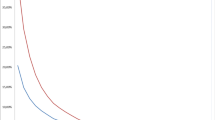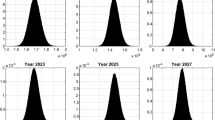Summary
The well-known inflation-independent exposure rating curves from Property reinsurance (see e.g. Mack (1980) or Bernegger (1997)) cannot be deduced in Liability insurance in the same way because here the claims sizes cannot be assumed to be scaled by the sums insured. Instead, German insurance and reinsurance companies apply a specific system of increased limits factors introduced already in 1936 by the pioneer of German non-life insurance mathematics, Paul Riebesell.
In the paper, Riebesell’s system is analysed in the light of the Collective Model of Risk Theory. It is shown that Riebesell’s system is consistent with the Collective Model only above some threshold u>0 and under the assumption that there the claims sizes have a Pareto distribution F(x)=1 − (x/c)−α with parameters c<u and α <1. Furthermore, evidence is given that the admissible range of values for α and u is reasonable for practical applications. Thus, Riebesell’s system provides an easy and consistent way of exposure rating which does not have to be adjusted for inflation or changes of currency.
Zusammenfassung
Die in der Sach-Rückversicherung wohlbekannten, inflationsunabhängigen Exposure-Kurven (vgl. z.B. Mack (1980) oder Bernegger (1997)) können für die Haftpflichtversicherung nicht in derselben Weise hergeleitet werden, da hier die Versicherungssummen nicht wie in der Sachversicherung als Größenmaß für die Schadenhöhen angesehen werden können. Stattdessen verwenden viele deutsche Erst- und Rückversicherer ein spezielles Zuschlagssystem für Versicherungssummenerhöhungen, das schon 1936 von dem Pionier der deutschen Schadenversicherungsmathematik, Paul Riebesell, eingeführt wurde.
In der vorliegenden Arbeit wird Riebesells Zuschlagssystem auf der Basis des Kollektiven Modells der Risikotheorie analysiert. Es wird gezeigt, dass Riebesells Zuschlagssystem nur oberhalb einer Versicherungssummengrenze u>0 konsistent mit dem Kollektiven Modell ist, und dass die Schäden dort Pareto-verteilt sein müssen mit Verteilungsfunktion F(x)=1 − (x/c)−α, wobei c<u und α<1 gelten muss. Weiterhin wird gezeigt, dass diese Bedingungen an die Werte von u und α in aller Regel keine Einschränkung für die praktische Anwendung bedeuten. Riebesells System kann daher als einfache und theoretisch fundierte Möglichkeit der Exposuretarifierung von Haftpflichtrisiken angesehen werden, die zudem noch inflations- und währungsunabhängig ist.
Similar content being viewed by others
References
G. Benktander andC. O. Segerdahl (1960): On the Analytical Representation of Claim Distributions with Special Reference to Excess of Loss Reinsurance. Transactions Int. Cong. Act. 16, Vol. 1, 626–648.
S. Bernegger (1997): The Swiss Re Exposure Curves and the MBBEFD Distribution Class. ASTIN Bulletin 27, 99–111.
S. A. Klugmann, H. H. Panjer andG. E. Willmot (1998): Loss Models. New York.
Th. Mack (1980): Über die Aufteilung des Risikos bei Vereinbarung einer Franchise. Blätter der DGVM XIV, 631–650.
P. Riebesell (1936): Einführung in die Sachversicherungsmathematik. Berlin.
H.-P. Sterk (1979): Selbstbeteiligung unter risikotheoretischen Aspekten. Karlsruhe.
J. Strauß (1975): Deductibles in Industrial Fire Insurance. ASTIN Bulletin 8, 378–393.
Author information
Authors and Affiliations
Rights and permissions
About this article
Cite this article
Mack, T., Fackler, M. Exposure-rating in liability reinsurance. Blätter DGVFM 26, 229–238 (2003). https://doi.org/10.1007/BF02808374
Issue Date:
DOI: https://doi.org/10.1007/BF02808374




